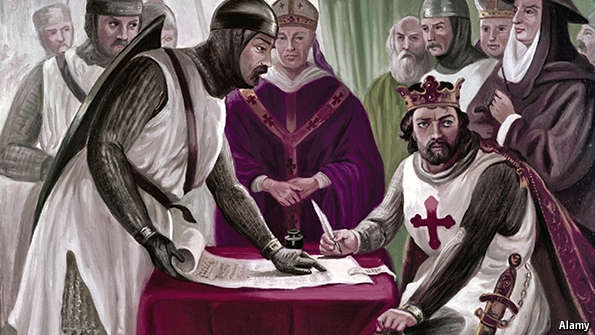IN 1215 England’s King John was in trouble. He had spent heavily on a failed attempt to regain bits of France; the French were threatening to invade; rebellious barons, whom he had been fleecing to finance his wars, were marching against him. He had no choice but to sue for peace with the rebels; the peace treaty, sealed at Runnymede on the Thames on June 15th, was called the Magna Carta. Since the barons had the upper hand, its main thrust was to protect their rights against monarchical abuse. It did not, as some suppose, spawn democracy (which only started to emerge even in embryonic form rather later) or trial by jury (which was already in use). But its chapter 39 (29 in subsequent versions) asserted the right to due process of law—“no free man shall be seized or imprisoned…except by the lawful judgment of his equals or by the law of the land”—for which it has been revered ever since.
As a peace treaty, it was a failure: John reneged on it a month later. But the charter survived because the king died the following year and William Marshal, regent to the nine-year-old Henry III, reissued it to persuade the rebel barons to support the young king against the French. It worked: the barons rallied round and the charter was revised and reissued several times.
Still, the Magna Carta might have disappeared into the mists of medieval history were it not for two political turning points at which revolutionaries found it convenient to present themselves as traditionalists. The first was the English civil war, when Sir Edward Coke, former chief justice, dug up the charter and used it in service of his argument that there was precedent for limiting the power of the monarch. It thus formed the basis of the Petition of Right, a proto-constitution which the parliamentarians forced the king to sign. The second turning point at which the Magna Carta resurfaced was the American war of independence, when rebellious colonists cited the charter against parliament just as parliament had used it against the king.
There is not much of the Magna Carta left now. Hundreds of copies were probably distributed but only four—two in the British Library, one in Lincoln Cathedral and one in Salisbury Cathedral—survive. The great majority of its provisions have been repealed: of the original charter’s 63 chapters only three—one confirming the freedom of the church, one confirming the liberties of the City of London and the crucial chapter 39—remain on Britain’s statute book. But as an emblem of the long struggle of people everywhere against the excesses of an arbitrary ruler, it retains great power.
Source: The Economist


